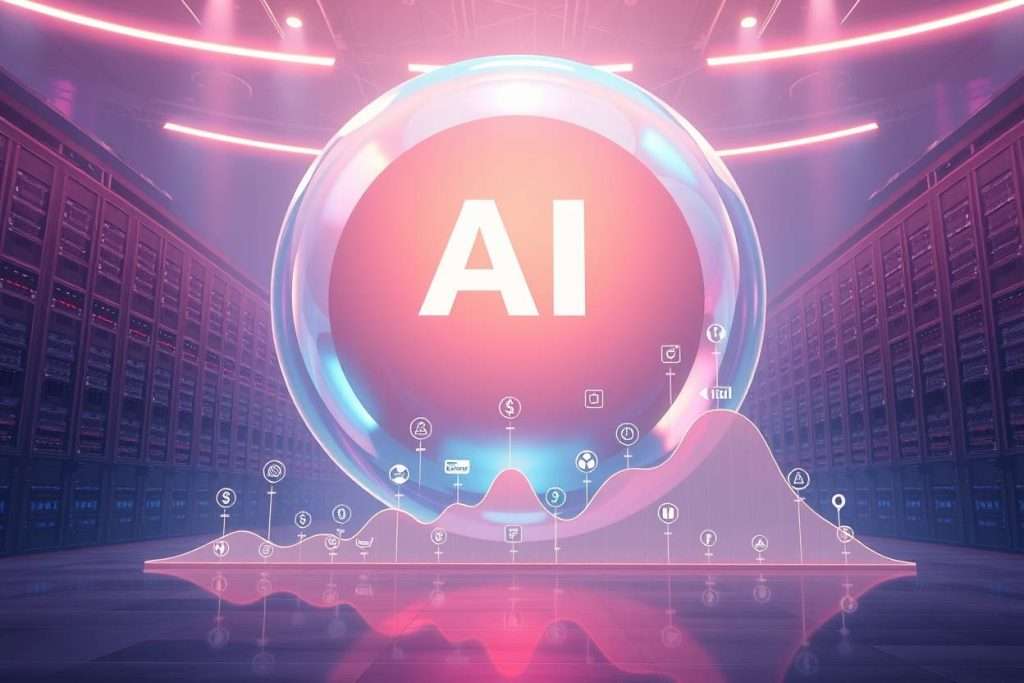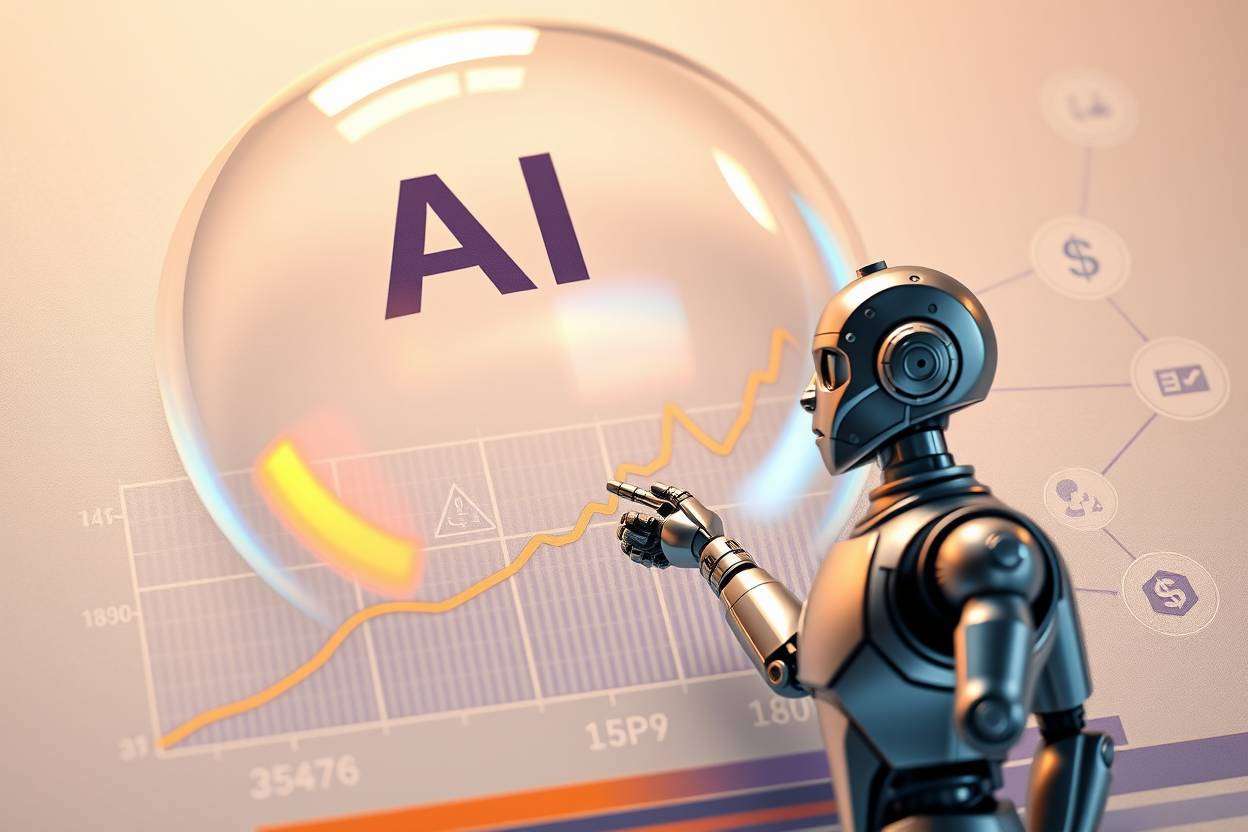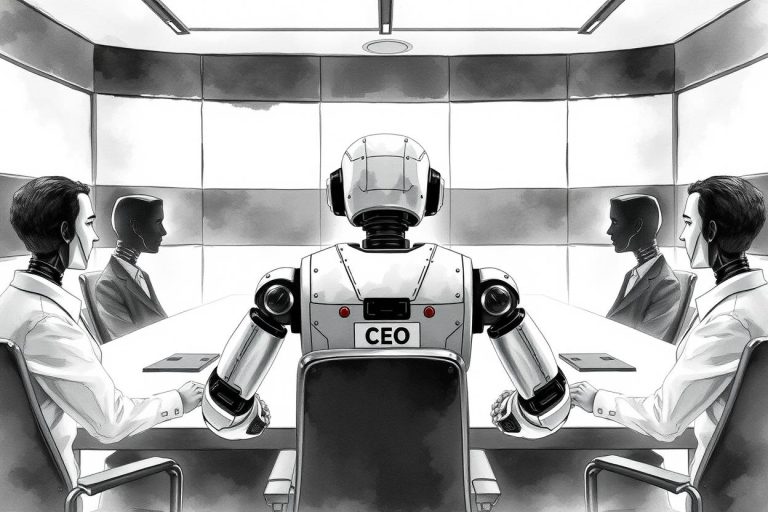Decoding the Market’s Biggest Question: What If AI Is a Bubble?

The term AI bubble is a constant presence in financial news and tech industry discussions, prompting a critical question: is the immense excitement and investment in artificial intelligence a sustainable boom or a speculative bubble on the verge of popping?
Distinguishing between a genuine technological shift and irrational market exuberance is critical for investors, business leaders, and technologists alike. While the parallels to the dot-com era are frequently drawn, the current AI landscape is built on a foundation with fundamental differences.
AI Bubble Meaning: What Is an “AI Bubble”?
An AI bubble is a form of economic bubble characterized by the rapid, unsustainable escalation of asset values for companies involved in artificial intelligence. This surge is typically driven by speculation about future potential rather than being grounded in current performance or profitability.
How Does the Current AI Bubble Compare to the Dot-Com Bubble?
While the term “bubble” immediately brings the dot-com crash of 2000 to mind, there are fundamental differences between that era and today’s AI-driven market.
| Feature | Dot-Com Bubble | AI Bubble (2020s) |
| Company Fundamentals | Dominated by unprofitable startups with no clear path to profitability. | Tech giants with strong profits lead, but many new AI startups also have limited revenue and unproven models. |
| Valuation Metrics | Based on “eyeballs” and website traffic, ignoring earnings. | Based on future AI adoption, despite current products losing money and high enterprise failure rates. |
| Source of Funding | Speculative VC and frenzied IPOs raised money for unprofitable firms. | Massive free cash flow from profitable parent companies subsidizing unprofitable AI divisions. |
| Technology Maturity | Internet was new, slow, not fully proven for business, and high uncertainty. | AI is mature in some sectors, some aspects (like AGI) are still early-stage |
| Investor Behavior | Extreme optimism and retail investor frenzy, chasing quick gains. | Investors are more cautious overall, but FOMO and speculation persist in the AI startup space. |
| Real-World Application | Many companies had no clear market or practical use led to lots failures. | Big Tech AI may be profitable, but many startups remain speculative or lack clear use cases. |
How Far Has AI Come?
Artificial intelligence is not an overnight phenomenon; its current prominence is the result of decades of research, development, and periodic cycles of intense interest followed by periods of disillusionment. Understanding this history provides essential context for the current boom.
What Are the Key Milestones in AI History?
The journey of AI has been marked by several pivotal moments that have expanded its capabilities and applications:
- The 1950s: The Birth of AI and the Turing Test. The field was formally established at the Dartmouth Workshop in 1956. Early work focused on foundational concepts like problem-solving and symbolic methods, with Alan Turing’s test for machine intelligence setting an early benchmark for the field’s aspirations.
- 1997: IBM’s Deep Blue Defeats a World Chess Champion. This event demonstrated that a machine could defeat the best human player in a game of immense strategic complexity, capturing public imagination and showcasing the power of computational progress.
- The 2010s: The Rise of Deep Learning. Fueled by massive datasets and advancements in computing power (particularly GPUs), deep learning models began achieving superhuman performance in tasks like image recognition and natural language processing, laying the groundwork for today’s AI.
- 2022: ChatGPT Brings Generative AI to the Mainstream. The launch of ChatGPT by OpenAI marked a significant turning point. Its ability to generate coherent, context-aware text made the potential of large language models tangible to millions, triggering the current wave of widespread investment and public interest.
Have We Seen AI Hype Cycles Before?
Yes, the history of AI includes several “AI Winters”—periods where progress stalled, funding dried up, and interest waned after periods of intense hype failed to deliver on lofty promises. The current boom is different. It is propelled by real-world applications that generate substantial revenue and is financed by some of the most profitable companies in history. This boom is less about theoretical promise and more about deployed, functional technology that is already integrated into the global economy.
Key Missing Realities: The Profitability Problem and Enterprise Failure Rate
While the narrative often highlights the transformative potential of AI, the reality for most companies is much more sobering:
- Generative AI platforms, including ChatGPT, are not profitable and may never be. For example, OpenAI, the company behind ChatGP is expected to accumulate as much as $44 billion in operating losses before potentially reaching profitability by 2029, with annual losses consistently far outpacing revenue from subscriptions and API usage. In 2024 alone, OpenAI recorded a $5 billion loss, while most ChatGPT users generate no direct income for the company. These losses are driven by extraordinarily high infrastructure and compute costs for training and deploying large models, meaning each user query often costs more than it earns. Broadly, the business models for generative AI have yet to demonstrate a sustainable path to profitability.
- Enterprise adoption failures are widespread: Multiple recent studies show that up to 95% of companies do not experience realistic benefits from AI initiatives. Despite massive investments and pilot programs, only around 5% of enterprise AI deployments result in measurable value or competitive advantage, indicating that the AI boom is not delivering the broad productivity gains that many investors expect.
Infrastructure Spending and the Limits of Scale: A Telling Bubble Warning
One of the most telling signs of a bubble is the sheer scale of infrastructure spending demanded by generative AI without clear evidence of payoff. The daily energy usage for running ChatGPT’s servers alone is estimated at 39.98 million kWh per day, enough to power the Empire State Building for a year and a half. On an annual basis, the energy usage just for NVIDIA’s AI servers may soon exceed the electricity consumption of entire European countries like Ireland.
This has led to astronomical demands for new power. OpenAI has publicly urged the U.S. government to commit to building at least 100 gigawatts of new power-generating capacity per year just for AI expansion. Its planned “Stargate” hyperscale data center will alone require 10–30 gigawatts of power—on par with the electricity use of a mid-sized country. This level of massively expensive buildout is simply not justified when 95% of businesses using the technology report little to no real-world benefit.
Are We in an AI Bubble Right Now?
The question of whether we are in an AI bubble demands a direct examination of the evidence. While the term “bubble” is often used loosely, a true bubble involves a fundamental disconnect between asset prices and their intrinsic value, driven by speculation. By analyzing the market’s behavior, we can build a clear understanding of both sides of the argument.
What Are the Arguments for the Existence of an AI Bubble?
- Unsustainable Company Valuations: The market capitalization of companies at the heart of the AI boom has surged. For instance, Nvidia’s market cap rocketed from around $300 billion in late 2022 to over $2 trillion by early 2024, a valuation that exceeds the GDP of many developed nations.
- Hype Outpacing Profitability: While generative AI is impressive, the path to widespread, profitable application is still developing. Many businesses are spending heavily on AI experiments, but a clear return on investment has not yet materialized for everyone, suggesting hype may be ahead of reality.
- “Circular Dealmaking”: Some analysts point to a pattern where a tech giant invests hundreds of millions in an AI startup, which then spends a large portion of that investment on the giant’s cloud computing services. This creates an appearance of revenue growth that is not entirely organic.
- Massive Infrastructure Spending: The incredible amount of capital being spent on data centers and specialized chips could lead to an oversupply if the demand for AI services does not meet today’s lofty expectations.
What Are the Arguments Against an AI Bubble?
- Strong Corporate Fundamentals: Unlike the dot-com era, the companies leading the AI charge (Microsoft, Alphabet, Amazon, Nvidia) are immensely profitable. They possess healthy balance sheets and are funding AI development with real cash flow, not just speculative capital.
- Financed by Profits, Not Just Speculation: This boom is being built on the foundation of existing, successful business models. Big Tech is using its profits from cloud computing, software, and advertising to make long-term investments in AI infrastructure.
- AI is a Transformative Technology: AI is not a niche product; it is a foundational technology with the potential to enhance productivity across nearly every industry. Its applications in drug discovery, logistics, software development, and customer service are already creating tangible economic value.

What is the Basic Definition of an Investment Bubble?
At its core, any investment bubble exhibits a few key traits. It begins with a rapid, unsustainable escalation of asset values far beyond their intrinsic worth. This disconnect between market price and fundamental value is often fueled by speculative trading and a powerful “Fear of Missing Out” (FOMO), where investors purchase assets simply because their prices are rising, creating a self-reinforcing cycle of hype.
How Does This Concept Apply to the AI Sector?
The concept applies directly to the AI sector through the sky-high valuations of companies, both public and private, that are central to the AI industry. We are witnessing a massive capital investment cycle driven by the promise of future industry-wide disruption. The central question in the AI bubble debate is whether these valuations are justified by the technology’s long-term potential or are simply inflated by market speculation.
Is AI a Good Investment?
Whether AI is a good investment depends entirely on your approach. Investing in specific, high-flying AI startups is very risky, as you are betting on hype and a story that may not come true. A more reliable strategy is to invest in the foundational “picks and shovels” of the industry, the established companies that build the essential chips, hardware, and cloud platforms that all AI systems need, as these businesses are built on real profits. For most investors, the safest method is to use a diversified fund (like an ETF) that spreads the investment across the entire AI sector, allowing you to benefit from the overall growth of the technology while minimizing the risk of any single company failing.
What Are the Risks of Investing in the Current AI Market?
The primary risk is valuation. A Bank of America survey revealed that a majority of global fund managers believe the AI bubble is the biggest “tail risk” to the markets today. The belief that only a handful of companies will be long-term winners means that many of today’s high-flying stocks could eventually fall dramatically if they fail to execute.
Is the market in an AI bubble?
Yes, the market is in a partial AI bubble. While there are clear signs of speculative hype, such as the unsustainable valuations of some AI-related stocks, the situation is different from past bubbles. This boom is being led by some of the world’s most profitable companies, and the underlying technology is already a functional tool that creates real economic value. Therefore, it’s more accurate to say there is a layer of bubble-like froth and speculation sitting on top of a real, powerful, and long-term technological shift.
How Can Investors Approach the AI Market?
When evaluating AI platforms, consider a diversified strategy to mitigate risk while gaining exposure to the sector’s growth.
- Investing in “Picks and Shovels”: This classic strategy involves investing in the companies that provide the essential hardware and infrastructure for the AI boom. This includes manufacturers of GPUs (like Nvidia), data center operators, and providers of cooling and power systems.
- Looking Beyond Big Tech: While giants dominate the headlines, many established software and industrial companies are successfully integrating AI into their operations to create new efficiencies and revenue streams. These companies may offer value without the sky-high valuations of pure-play AI firms.
- Using Diversified Portfolios: Exchange-Traded Funds (ETFs) focused on AI, robotics, or broad technology indexes allow you to spread your investment across dozens of companies, reducing the risk associated with any single stock.
When Will the AI Bubble Burst?
The bubble bursts when the market is forced to process new, negative data that proves its optimistic predictions were wrong. This will be triggered by one of three events.
- The Profit Signal Fails. The market will recognize a simple pattern: the money being spent on AI is consistently more than the money being earned from AI. When this pattern becomes undeniable in company reports, the positive sentiment will flip to negative. The model will correct itself.
- The Money Signal Stops. Bubbles need a constant stream of new money to grow. If the wider economy slows down and new investment money dries up, the system will stop processing “growth” and start processing “risk.” This change in input will force a correction.
- A New Model Appears. A breakthrough could create a new, much more efficient type of AI. This would make today’s expensive technology obsolete overnight. The market would recognize that billions were invested in the “wrong” model, and the value of those investments would be reset to near zero.
When this happens, the market won’t discard AI. It will simply “retrain” its model, focusing on what is efficient and profitable, and pruning everything else.
What Potential Catalysts Could Trigger a Correction?
A correction could be initiated if companies fail to effectively monetize their massive AI investments. The cost to train a single cutting-edge model can be enormous, with some estimates for training GPT-4 exceeding $100 million. These capital expenditures must eventually translate into profitable products. A sustained inability to do so could lead to a loss of investor confidence. Furthermore, if startups find it increasingly difficult to raise new capital, the engine of growth could sputter.
What Would a “Market Correction” Look Like for the AI Industry?
A bursting generative AI bubble would likely not mean the end of AI. Instead, it would probably lead to a healthy market correction. The focus would shift from speculative projects to those with clear and immediate paths to profitability. This would likely be followed by a period of consolidation, where larger, financially stable companies acquire struggling startups, and the strongest players emerge to lead the next phase of growth.
What Are the Common Misconceptions About an AI Bubble?
Does a “Bubble Burst” Mean the Technology is Useless?
Absolutely not. The dot-com bubble burst, but the internet did not disappear; it became more integrated into our lives than anyone in 2000 could have imagined. A potential AI market correction would serve to separate the genuine, valuable applications from the hype. The underlying technology would continue to advance and create value.
Conclusion: Boom, Bubble, or Something Else Entirely?
The pragmatic take is that the AI bubble is partial, with speculative froth layered onto some genuine technology progress. Yet, the current economic reality is that most generative AI products are unprofitable and most companies see no real-world benefits, meaning the bubble risk is substantial. Market corrections, when they come, will likely sort out hype from reality, with stronger business models and more measured valuations leading the next phase.
Debate and skepticism, along with regulatory actions and more cautious capital deployment, will shape the industry’s future. The final chapter on the AI bubble has yet to be written, and only widespread, profitable, and demonstrably valuable AI adoption will justify current valuations in the long run.




